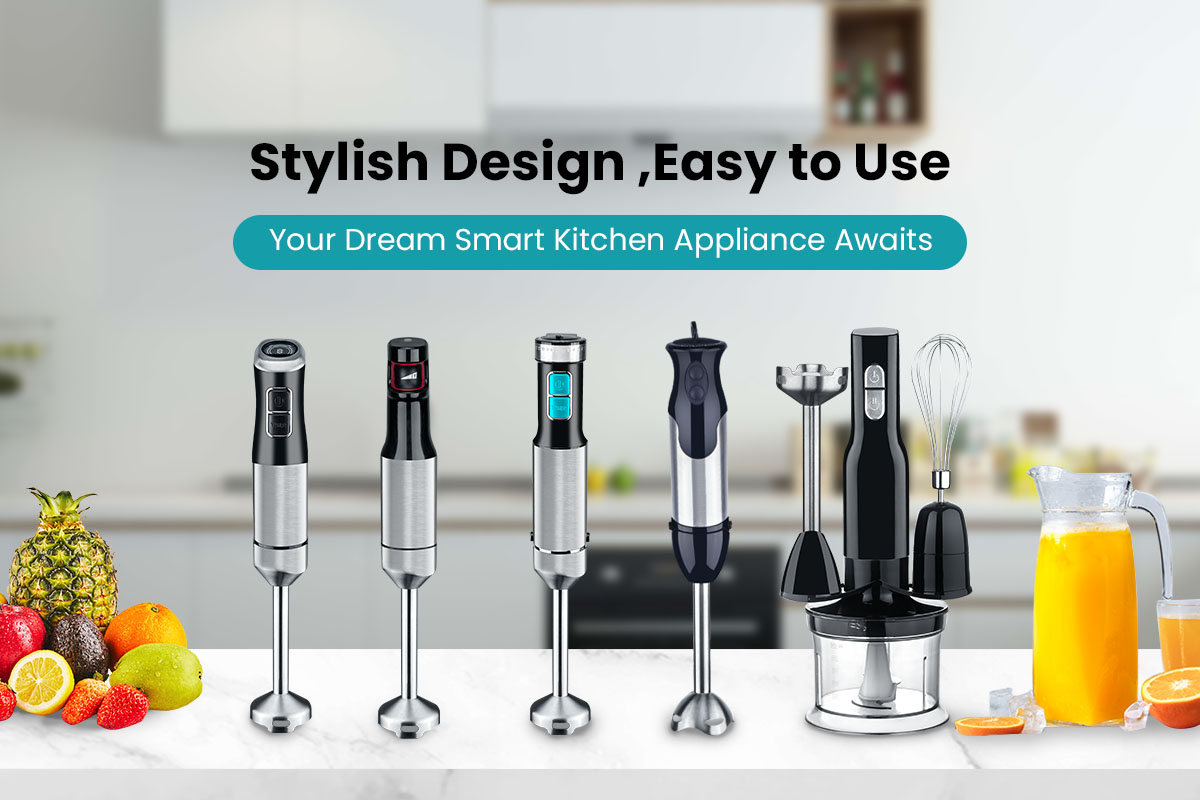Can Hand Blender Chop Vegetables
Yes — a Hand Blender can chop vegetables, but only when it comes with a chopper or Food Processor attachment. The main blending stick alone is designed for pureeing and mixing, not chopping solid ingredients. However, many modern hand blenders include detachable chopper bowls with stainless steel blades, which make chopping vegetables quick, consistent, and effortless.
In this article, we’ll explain how a hand blender can chop vegetables effectively, what types of vegetables work best, and the advantages of using one — with expert insights from KANGJIA Electrical Appliances Co., Ltd., a professional manufacturer of versatile hand blenders and kitchen appliances.
1. The Short Answer
✅ Yes, a hand blender can chop vegetables — if equipped with a chopper attachment.
❌ No, the stick blender alone cannot chop solid or hard ingredients properly.
The chopper attachment typically consists of:
A small container or bowl
A stainless steel blade assembly
A lid connector that attaches to the motor body of the hand blender
This setup allows the motor to spin the blades at high speed, cutting vegetables evenly and safely.
KANGJIA hand blenders offer optional chopper attachments that turn your blender into a mini food processor — ideal for onions, garlic, herbs, nuts, and more.
2. How It Works
When you connect the chopper bowl to the hand blender body, the rotating blades slice through vegetables in seconds.
The high-speed motor delivers consistent torque.
The sharp double blades rotate rapidly for even cutting.
The closed container prevents splashing or flying pieces.
The result: uniformly chopped vegetables with minimal mess.
This is especially efficient for meal prep tasks like chopping onions, mincing garlic, or dicing carrots — all done in seconds.
3. How to Chop Vegetables with a Hand Blender
Step 1: Prepare the Attachment
Connect the chopper bowl to the motor handle.
Make sure the blades are securely in place.
Step 2: Cut Vegetables into Small Pieces
Slice large vegetables into 2–3 cm chunks first.
This prevents jamming and ensures even chopping.
Step 3: Add Ingredients to the Bowl
Place the vegetables in the bowl.
Fill only halfway to avoid overloading.
Step 4: Pulse, Don’t Hold
Use short pulses instead of continuous blending.
Shake or tap the bowl gently between pulses for uniform results.
Step 5: Check and Adjust Texture
Stop when vegetables reach the desired size — coarse for stir-fries, fine for sauces.
Over-processing will turn them into paste.
KANGJIA’s hand blenders feature pulse control and multi-speed settings, giving users precise command over chopping size — from rough dice to fine mince.
4. Best Vegetables to Chop with a Hand Blender
| Vegetable Type | Works Well? | Notes |
|---|---|---|
| Onions & Garlic | ✅ Excellent | Quick, even chopping with no tears |
| Carrots & Celery | ✅ Good | Cut into small chunks first |
| Tomatoes & Peppers | ⚠️ Yes (briefly) | Too long = puree |
| Cabbage & Spinach | ✅ Great | Ideal for coleslaw or fillings |
| Potatoes | ⚠️ Possible | Short pulses only — avoid mush |
| Herbs (parsley, coriander) | ✅ Excellent | Retains flavor and texture |
| Nuts & Seeds | ✅ Yes | Great for coarse chopping or nut butter base |
The key is timing — pulse briefly for chopping, hold longer for blending.
5. When to Use and When Not To
✅ Best For
Quick vegetable prep (onions, garlic, herbs, carrots)
Making salsa, dips, or sauces
Chopping nuts or cooked meats
Preparing fillings or toppings
❌ Not Ideal For
Very hard vegetables (raw beets, frozen items)
Dry ingredients without liquid
Continuous heavy-duty chopping (use a food processor instead)
The hand blender is perfect for everyday kitchen prep, but not meant for bulk chopping of dense foods.
6. Hand Blender vs. Food Processor for Chopping
| Feature | Hand Blender (with chopper) | Food Processor |
|---|---|---|
| Capacity | Small (up to 500ml) | Large (up to 2L) |
| Speed | Quick for small tasks | Better for big batches |
| Control | Excellent for fine adjustment | Consistent for bulk use |
| Cleaning | Very easy | More parts to clean |
| Space Saving | Compact | Bulky |
| Versatility | Blends, chops, purees | Only chops/slices |
For daily use, a multi-functional hand blender like those from KANGJIA combines the convenience of blending, chopping, and whipping — all in one tool.
7. Safety Tips
| Tip | Why It’s Important |
|---|---|
| Unplug before cleaning | Prevents accidental activation |
| Do not overfill bowl | Ensures even chopping |
| Avoid ice or frozen items | Can dull blades |
| Use pulse control | Prevents overheating and mushy texture |
| Handle blades carefully | Sharp edges can cut fingers |
KANGJIA chopper attachments use stainless steel safety blades designed for long-term durability and easy cleaning.
✅ Summary
| Step | Action | Key Tip |
|---|---|---|
| 1 | Attach chopper bowl | Ensure blade is secure |
| 2 | Cut vegetables smaller | Prevent jamming |
| 3 | Add ingredients halfway | Allow space for motion |
| 4 | Pulse gently | Control texture |
| 5 | Clean and dry | Maintain performance |
Final Thoughts
A hand blender with a chopper attachment is one of the most practical tools for modern kitchens — it lets you chop, mince, and blend using a single appliance. It’s compact, easy to clean, and perfect for daily cooking.
If you want efficient chopping power without the bulk of a food processor, choose a multi-speed stainless steel hand blender, like those made by KANGJIA Electrical Appliances Co., Ltd.. Their models combine blending, whisking, and chopping attachments to handle everything from soups to salads with precision.
In short: a hand blender can absolutely chop vegetables — just use the chopper attachment, pulse gently, and you’ll get perfectly cut ingredients in seconds.





